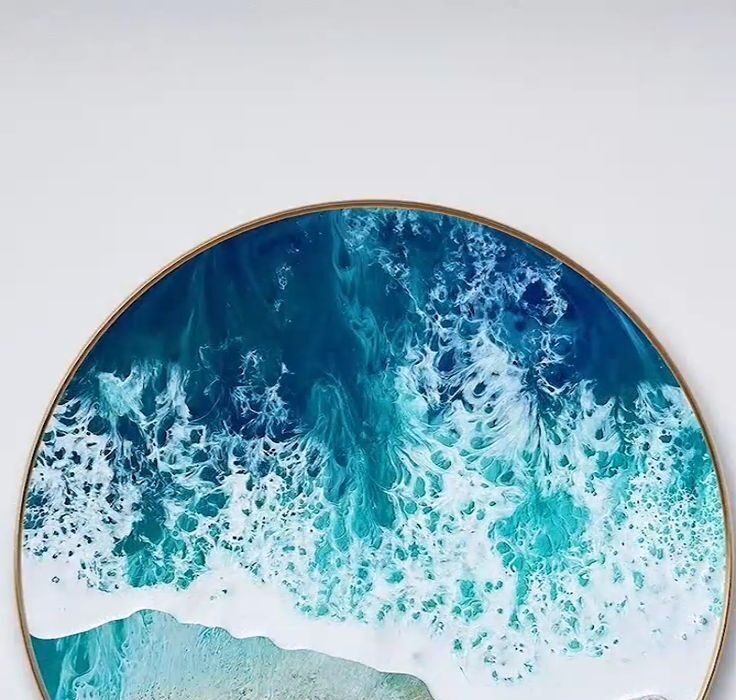Do you want to start your journey with epoxy resin? This material is especially useful for those beginners who just begin their way in the world of crafting as well as for those experienced crafters who can find a new scope in this material. From generating marvelously beautiful earrings, rings, bracelets, necklaces, and other ornaments to fashioning creatively home decors, tole art pieces and other trinkets, epoxy resin is truly indispensable cross-stitching material. Its versatility to adhere, seal and finish makes it suitable for several kinds of applications. It will pay to know something about epoxy resin prior to pouring and mixing, though. It is important also to know its different forms, plus it’s advantage and how you can tread it to unleash your creative ability!
What is Epoxy Resin
Epoxy resin – is a synthetic polymer material that in general is appreciated for its durability and its variability. It’s created by mixing two components: a resin and a hardener. The two then undergo a reaction where the homogeneous liquid mixture changes to a type of solid mass.
This wonderful material is ideally sticky for many uses in arts and crafts and building. These are features that make epoxy unique from other resins, the ability to withstand heat, chemicals and moisture.
Epoxy is a favorite among crafters as it produces a clear coat and has a sheen too. After it has gotten slightly hard, it can be sanded or polished to make it even shinier than before.
Also, epoxy can be colored using pigments or the epoxy can be mixed with other materials such as glitter and flowers among others. It’s not just bonding; it’s more of making fine pieces of art work that draw the attention of one and all!
The Different Types of Epoxy Resin
For any beginner wishing to venture into using epoxy resin, it is essential to learn more about the type which exists. These ingredients all have their role and their characteristics, as described below:
One sub type is the clear epoxy resin. It is ideal for making items to have attractive, clear layers that reveal the underlying details of work. It is widely used in jewelry and even in metal artwork.
Another type of epoxy resin is colored or pigmented epoxy resin, for example epoxy resins containing carbon nanotubes. It is used by crafters to introduce bright colors to their work. These resins can be used to fabricate great looking coasters or tabletops.
Some epoxy resins have flexibility together with elasticity and this makes them to be appropriate for use in cases where there is movement. They’re ideal when used to create items such as phone cases or any other wearable product.
Out there on the market are different types of epoxies created specifically for given applications for instance there are marine grade epoxies which are resistant to water penetration. By knowing these differences possible buyers will be able to select the appropriate material for their artistic projects.
Benefits of Working with Epoxy Resin
Looking at the properties of epoxy resin, we’ll see why it is loved by crafters: Quite a number of people love the product because of its durability. When cured epoxy provides strength to the bonded surface while also protecting projects from day to day use.
Another advantage is flexibility Future studies can build on the methods adopted in this study such as the use of annotated checklists to replicate the study with different populations, or use the results as a benchmark to make their studies more comprehensive. They range from jewelry setting, tabletops and even art work whereby epoxy presents flexibility when used. They come in a plain color and can be colored or formed to any shape as the creator desires.
The result from the glossy finish created by epoxy is a striking feature on any surface that it has been applied on. This gives the appearance a polished look to colors and details making it look even better.
Another advantage of using epoxy resin is the usual high level of adhesion when working with other materials. It forms a strong bond to many of the substrates such as wood, metal and glass. This also means you can mix your ‘ingredients’ however you wish with out the complication of material compatibility.
Another advantage is that it has inherent self-leveling capability, which makes it easier to use the product. When applied correctly it easily lays into place, without leaving marks or bubbles on the underlying surface and can be used by raw beginner – all the while attracting the more accomplished artist.
Common Uses for Epoxy Resin in Crafting
Using epoxy resin is incredibly popular because it can be used for just about everything and is favored by artisans. One of the most common uses is in jewelry, specifically as large pendants and earrings, which demonstrate flowers being embedded or glitter.
Furniture designers use the epoxy resin to design special tabletops as well. It means that we have beautiful, colorful wooden pieces which serve both decorative and practical purposes.
Lovers of art use epoxy by pouring on canvas then let it dry for the shiny look. This technique increases the density of the coloring and adds a layer which safeguards them against scratches.
The epoxy coasters can be designed with any type of design which makes it suitable for gift giving. Other uses that most people find suitable include when they want to make useful decorative items such as picture frame or sculptures.
It is one material the craft world has adopted not for its beauty alone but for the fact that it is very hard wearing. Epoxy resin is a fantastic option for artists – whether they are making small accessories or art pieces.
Step-by-Step Guide on How to Work with Epoxy Resin
First of all collect all the materials you have on you. The tools that you will be used are epoxy resin, hardener, the mixing cups, the stir sticks, and gloves. They look for good light and air conditions in the work place.
Subsequently, weigh the correct portion of the resin and the hardener as described by the producer. There is a great need for precision here for a cure to take effect.
Combine them in a mixing cup. If necessary, mix the ingredients for about three minutes or until you get a good homogeneous solution that has no bubbles. Time taken while performing this step is rewarded with accuracy.
When achieving enhanced stiffness, drain it slowly in your mold or project region. This helps reduce chances of formation of bubbles of air and also aids in creating better distribution of the described polymer.
If you have chosen to introduce color or other accessories now will be the right time to introduce them into the poured resin.
Let them cure as required – this took anything between several hours and days based on conditions and product requirements. Some reinforcement: try not to let dust or anything else settle on top though while it’s setting!
Safety Precautions When Working with Epoxy Resin
While using epoxies it is very important to ensure that you have taken all the necessary precaution to enhance you safer. This material gives off dangerous emissions when being cured and therefore requires proper ventilation in the work area. Setting up the windows to be opened if possible as well as make use of fans.
Measures that should be taken include observing universal precaution by putting on standard personal protective clothing. Buy some quality hand gloves for protecting your hands from skin contact. Facial protection also needs protection of eyes anticipating any chances of splashes or accidental drips.
If you have some sort of allergy or if you easily get irritated by smells, especially if you have respiratory problems, then there are masks specially made for chemical vapors. Quite literarily, it is better to err on the safe side when using our respiratory systems in the occupationally exposed manner and for inhaled substances to err on the dangerous side.
A basic guideline to consider is to always read the manufacturer’s guidelines before beginning a project. Some brands may even have different ratios for their mix and some specific periods before you can apply the next layer of paint that you will need to adhere to strictly.
Store ALL materials away and out of sight from children and/or pets, as epoxy water has been known to be more toxic if swallowed. Products for crafting should be kept in appropriately labeled containers to ensure safety at the workplace.
Remember that spills happen! Using paper towels or absorbent cloths must be available nearby so that you don’t get exposed in case of an accident. Adhering to the above guidelines will prepare you for safer crafting experience while exploring more of epoxy resins uses.





